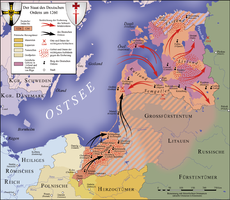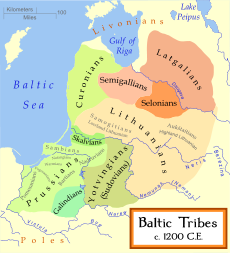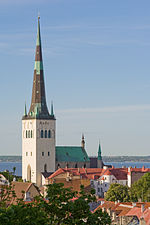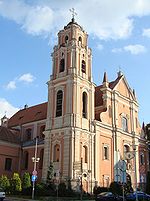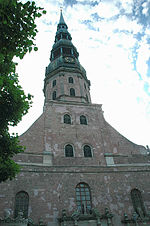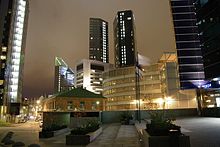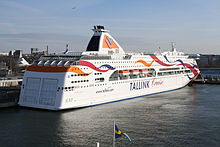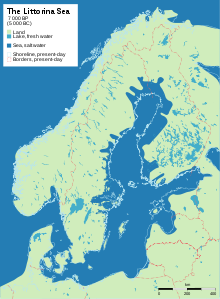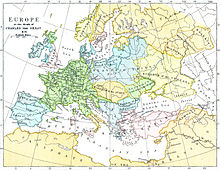- Baltic states
-
For other uses, see Baltic (disambiguation).
Baltic states Location of Baltic states (dark green)in Europe (dark grey) — [Legend]
Capitals Tallinn; Riga; Vilnius Official languages Estonian; Latvian; Lithuanian Membership  Estonia
Estonia
 Latvia
Latvia
 Lithuania
LithuaniaArea - Total 175,015 km2 (91st)
67,523 sq mi- Water (%) 2.23% (3,909 km²) Population - 2010 estimate 6,812,500 (100th) - Density 39.5/km2 (172nd)
102.4/sq miGDP (PPP) 2011 estimate - Total $119.567 billion[1] (62nd) - Per capita $17,465 (50th) GDP (nominal) 2011 estimate - Total $86.799 billion[1] (65th) - Per capita $12,679 (47th) The term Baltic states (also Baltics, Baltic nations or Baltic countries) refers to the Baltic territories which gained independence from the Russian Empire in the wake of World War I: primarily the contiguous trio of Estonia, Latvia, Lithuania (from north to south); Finland also fell within the scope of the term after initially gaining independence in the 1920s.
The term in the indigenous languages of the Baltic states is:
- Estonian: Balti riigid,
- Latvian: Baltijas valstis, and
- Lithuanian: Baltijos valstybės.
Contents
Etymology and toponymic history
The term "Baltic" stems from the name of the Baltic Sea – a hydronym dating back to the 11th century (Adam of Bremen mentioned Latin: Mare Balticum) and earlier. Peoples inhabiting the shores of the same sea often name it in different ways, and one of which generally becomes globally acknowledged (not so for the Persian Gulf), may correlate with the geopolitical balance of powers at a given time. Beginning in the Middle Ages and through the present day, the Baltic Sea appears on the maps subscribed in Germanic languages as German: Ostsee, Danish: Østersøen, Dutch: Oostzee, Swedish: Östersjön, etc. In English "Ost" is "East", and in fact, the Baltic Sea mostly lies to the east for Germany, Denmark, Norway, and Sweden. Clearly, part of the Baltic Sea lies to the east of Germany and Sweden, and due north of parts of Germany.
In the 17th century, the Kingdom of Sweden grew to be one of the great powers of Northern Europe.[2] However, at the beginning of the 18th Century "the Great Power Era" (Swedish: Stormaktstiden) of the Swedish Empire was challenged by the Russian Empire which was seeking to restore its access to the Varangians Sea -- as the Baltic Sea was called in the Land of Novgorod. De facto in 1700 - 09, and de jure beginning in 1721, Swedish Livonia (today the northern parts of Latvia and Estonia, and the western part of the Leningrad Oblast) which had been acquired by Sweden in accordance with Treaty of Oliva of 1660, came under the rule of the Russian Empire. Legalizing this acquisition by the Treaty of Nystad, instead of taking an indemnity from the defeated Swedes, the Russian Empire paid Sweden two million jefimoks, or about 980 kilograms of silver.[3] The first collective name for two administrative units established here in 1713 was Ostsee Governorates (Russian: Остзейские губернии).
Initially these were two governorates named after the largest cities: Riga and Reval (now Tallinn). After the Partitions of Poland which took place in the last quarter of the 18th century the third Ostsee Governorate was set, the one of Courland (presently a part of Latvia). This toponym stems from Curonians, one of Finnic[4] or Baltic[5] indigenous tribes. Accordingly, two others were renamed to the Governorate of Livland and the Governorate of Estland.
The presence of the Germanic morpheme "Ostsee" within the Russian collective name of those provinces is not limited to the personal inclination to the Western lexics which was showed by Peter the Great who conquered these lands from the Swedes. In fact, since the Livonian Crusade at the turn of the 13th century "Terra Mariana", Livland and Estland were under the German influence. These were Germans who formed the backbone of the local gentry, and for centuries German was the language of international communication and record keeping there.[6]
By coincidence, it was German philologist Georg Nesselmann living at the Baltics (in East Prussia) who in the middle of the 19th century substantiated the concept of Baltic languages[7] using the name of one of the local pagan tribes, the Balts. Endre Bojtár (1999) argues that it was around 1840s when the German gentry of the Governorate of Livonia devised the term "Balts" to mean themselves, the German upper classes of Livonia, excluding the Latvian and Estonian lower classes. They spoke an exclusive dialect, baltisch-deutsch, legally spoken by them alone.[6] Thus the usage of "Baltic" and similar terms to denote this region dates back not earlier than 1840s.
Simultaneously, in 1840s the usage "Ostsee" was superseded by "Baltic" in Russian. The article "Прибалтийский край" ("Baltic Krai") in the Brockhaus encyclopedia[8] and other sources[9] notes that 1840s mark a shift of the local population towards Russian language and, to a certain extent, to orthodoxy.
Lithuania occupies a specific place within the scope of the region named "Baltic states". Through many centuries of its history Lithuania was more than a state at a Baltic seacoast. Born at a turn of the 13th century[10] the Grand Duchy of Lithuania encompassed most part of Kievan Rus' and by the middle of 16th century stretched to the Black Sea. From 1569 it has been a backbone element of such large and strong geo-political power as Polish–Lithuanian Commonwealth, so it is not incidental that up to 1920s Lithuania was treated separately from the Baltic states. Only after Lietuvos Taryba proclaimed its independence in 1918, Lithuania began to be mentioned in the same list with her two northern neighbours.
The Latvian and Lithuanian term Baltija most likely originates from the Indo-European root *bhel meaning white, fair. In the 1920s, the newly-established countries of Estonia, Latvia, Lithuania and Finland, formerly territories of the Russian empire, were referred to as the Baltic states.[11]
The United Nations Group of Experts on Geographical Names defines a Baltic Division.[12]
Cultures and languages
Estonians and the nearly linguistically extinct Livonian people in Latvia are descended from the Baltic Finns, sharing closely related languages and a common cultural ancestry. The Latvians and Lithuanians, linguistically and culturally related to each other, are descended from the Balts, an Indo-European people and culture. The peoples comprising the Baltic states have together inhabited the eastern coast of the Baltic Sea for millennia, although not always peacefully in ancient times, over which period their populations, Estonian, Latvian, and Lithuanian, have remained remarkably stable within the approximate territorial boundaries of the current Baltic states. While separate peoples with their own customs and traditions, historical factors have introduced cultural commonalities across and differences within them.
The peoples of the Baltic countries belong to different Christian denominations, a reflection of historical circumstances. Both Western and Eastern Christianity had been introduced by the end of the first millennium. The current divide between Lutheranism to the north and Catholicism to the south is the remnant of Swedish and Polish hegemony, respectively, with Orthodox Christianity remaining the dominant faith among Russian and other Slavic minorities.
The languages of Baltic nations belong to two distinct language families. The Latvian and Lithuanian languages make up the group of Baltic languages which belongs to the Indo-European language family. The Estonian language and the nearly-extinct Livonian language, on the other hand, are not Indo-European languages and instead they belong to the Baltic-Finnic subgroup of the Finno-Ugric languages, sharing close ethnic and historical ties with the Finnish language and people.
The Baltic states have historically been in the Swedish (or, in Lithuania's case, Polish), German (historically: The Holy Roman Empire and Saxony), Danish, and Russian spheres of influence.
Apart from the indigenous languages, German was the dominant language in Estonia and Latvia in academics, professional life, and upper society from the 13th century until World War I. Polish served a similar function in Lithuania. Swedish remains spoken in Estonia, particularly among the Estonian Swedes of northern Estonia and the islands. Numerous Swedish loanwords have made it into the Estonian language; it was under the Swedish rule that schools were established and education propagated in 17th century. There is also significant proficiency in Finnish in Estonia owing to its closeness to the native Estonian and also the widespread practice of listening to Finnish broadcasts during the Soviet era. Russian also achieved significant usage particularly in commerce.
Russian was the most commonly studied foreign language at all levels of schooling during the Soviet era. The Soviet Union conducted a policy of Russification by encouraging Russians and other Russian-speaking ethnic groups of the Soviet Union to settle in the Baltic Republics. As they were neither encouraged nor motivated to learn the official local languages, knowledge of Russian became a practical necessity in daily life despite schooling available and administration conducted in local languages. Today ethnic Russian immigrants from former Soviet Union. and their descendants make up a sizable minority in the Baltic states, particularly in Latvia (about one-third of the total population and majority in the capital Riga) and Estonia (one-quarter of the population).
Currently, the Baltic states have considerable Slavic populations, and knowledge of Slavic languages (particularly Russian). Latvia is 35.9% Slavic (including 27.5% Russian, 3.6% Belarusian, 2.5% Ukrainian, and 2.3% Polish), and 1,822,327 (76.7% of the population of Latvia) can fluently speak Russian. 28.8% of Estonia is Slavic (mostly Russian), and 12.3% of Lithuania is Slavic (mostly Polish).
Economies
Estonia, Latvia, and Lithuania have been members of both the European Union and the North Atlantic Treaty Organization since 2004. Today the three countries are liberal democracies and their market economies in recent years have undergone rapid expansion in early 2000s. However, the economies were hard-hit by the financial crisis of 2007–2010. According to projections by the International Monetary Fund (IMF), the GDP based on purchasing-power-parity decreased by 13% to 17% from 2008 to 2009.[13]
The Baltic states had the highest growth rates in Europe between 2000 and 2006, and this continued in 2007. In 2006 the economy in Estonia grew by 11.2% in gross domestic product, while the Latvian economy grew by 11.9% and Lithuania by 7.5%. All three countries saw their rates of unemployment fall below the EU average by February 2006. Additionally, Estonia is among the ten most liberal economies in the world and in 2006 switched from being classified as an upper-middle income economy to a high-income economy by the World Bank. Estonia adopted the euro in January 2011 whilst Latvia and Lithuania do not have a specified date, but Lithuania hopes to do the same in the following years and Latvia in 2014.
However, due to the global economic crisis, the Baltic economies in 2008 were fragile and the previous fast growth had switched to recession in Estonia and Latvia by the end of 2008, followed by Lithuania in 2009.
In 2009, unemployment rate rose to 13.7% in Lithuania, 17.3% in Latvia and 13.8% in Estonia, as compared to a "Advanced Europe" level of 8.8% (the 2009 unemployment rate in so called "Emerging Europe" countries was higher but still below that found in the Baltic states). Over the course of 2011, the unemployment rates are expected to rise even further, despite an expected recovery in output.[14]
In 2009, real aggregate GDP fell by 14.8% in Lithuania, by 18% in Latvia and 13.9% in Estonia, compared to an overall fall of 3.7% among all countries in the "Emerging Europe" group. Output is expected to recover somewhat in Lithuania and Estonia, with projected growth rates of 1.3% and 1.8% respectively, while in Latvia GDP is expected to fall by further 1%.[14]
Although Estonia has so far succeeded on keeping its debt-levels one of the lowest in the European Union, the southern Baltic states are in a more difficult situation. Rather defaulting on debt in the lead-up to the sub-prime mortgage crash, the Latvian government has responded to EU and IMF pressure by taking on private debt. Latvia accepted a 7.5 billion euro EU-IMF loan.
Histories
At 8000–5000 BC mesolithic hunter-gatherer communities of the Kunda culture at the southern shores of the Mastogloia Sea may have witnessed its transfiguration into Littorina Sea and finally to what is the Baltic Sea now.[15] Traces of Comb Ceramic Culture found on these territories date back to the beginning of the 4th millennium BC, and of the Corded Ware culture (pottery with corded decoration and well-polished boat-shape stone axes) to the beginning of the Late Neolithic Period. Fossils of the Bronze Age show the separation between the Finnic peoples and the Balts.
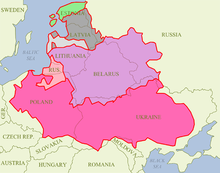 Outline of the Polish–Lithuanian Commonwealth in 1618, superimposed on present-day national borders. At the time, the Commonwealth incorporated most of the territory of the modern Baltic states.
Outline of the Polish–Lithuanian Commonwealth in 1618, superimposed on present-day national borders. At the time, the Commonwealth incorporated most of the territory of the modern Baltic states.
The CrownDuchy of Courland, Lithuanian fiefIn the 1st century, AD the people living in the area were first denoted by Tacitus as a form of Aestii.
In the 13th century, Christianity and feudalism were effectively forced upon modern Estonia and Latvia by the invasion of the crusaders from the west (German Sword Brethren, Denmark) and the conversion of Lithuania's rulers from Paganism to Christianity. While in Latvia and most of Estonia Livonian Confederation was established, Lithuania established its own state as the Grand Duchy of Lithuania some time before 1252. It later was a major political power of the region.
After the Livonian War in the 16th century, the Confederation ceased to exist, and its lands were incorporated into the Polish–Lithuanian Commonwealth. In 1621 most of the Duchy of Livonia was incorporated into the Swedish empire. During the Great Northern War the Dominions of Sweden of Swedish Estonia and Swedish Livonia were conquered by Russia and then ceded by Sweden in the Treaty of Nystad in 1721.
The Russian Empire gained control of most of the present-day Baltic states in the 18th century when the Polish–Lithuanian Commonwealth was partitioned in three stages by the Russian Empire, the Kingdom of Prussia, and the Habsburg Monarchy, while western parts of Lithuania were incorporated into Prussia.
Estonia, Latvia and Lithuania became sovereign nations in the aftermath of World War I. They declared independence in 1918, fought independence wars against German Freikorps and Bolshevist Russia, and were recognized as independent countries in 1920.
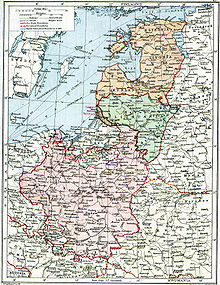 "Poland & The New Baltic States" map from 1920, showing still-undefined borders in the aftermath of World War I before the Peace of Riga
"Poland & The New Baltic States" map from 1920, showing still-undefined borders in the aftermath of World War I before the Peace of Riga
After independence, the Baltic States were sometimes referred to as limitrophe states[16] between the two World Wars, from the French, indicating their collectively forming a rim[17] along Bolshevik Russia's, later the Soviet Union's, western border. They were also part of what Clemenceau considered a strategic cordon sanitaire, the entire territory from Finland in the north to Romania in the south, standing between Western Europe and potential Bolshevik territorial ambitions.
Following the Molotov-Ribbentrop Pact of 1939, the Soviet Army entered eastern Poland as well as military bases in the Baltic states which were granted after U.S.S.R. had threatened the three countries with military invasion. In June 1940, the Red Army occupied all of the territory of Estonia, Latvia, and Lithuania, and the Red Army installed new, pro-Soviet governments in all three countries. Following rigged elections, in which only pro-communist candidates were allowed to run, the newly "elected" parliaments of the three countries formally applied to "join" the Soviet Union in August 1940 and were annexed into it as the Estonian SSR, the Latvian SSR, and the Lithuanian SSR.
The Soviet control of the Baltic states was interrupted by Nazi German invasion of this region in 1941. The German occupation lasted until late 1944 (in Courland, until early 1945), when the countries were reoccupied by the Red Army. In all three countries, Baltic partisans, known colloquially as the Forest Brothers, Latvian national partisans, and Lithuanian partisans (1944–53), waged unsuccessful guerrilla warfare against the Soviet occupation for the next eight years in a bid to regain their nations' independence.
In the late 1980s a massive campaign of civil resistance against Soviet rule, known as the Singing revolution, began. Baltic Way was one of the most spectacular events when a two-million-strong human chain stretched for 600 km from Tallinn to Vilnius on August 23, 1989. In the wake of this campaign «at least one of Gorbachev's had privately concluded that the departure of the Baltic republics had become ‘inevitable’».[18] This process contributed to the dissolution of the Soviet Union setting a precedent for the other Soviet republics to secede from the USSR. Soviet Union recognized the independence of three Baltic states on September 6, 1991. The last Russian troops were withdrawn from there in August 1994.[19]
Lithuania, Latvia and Estonia were considered to be under Soviet occupation by the United States, the United Kingdom, Canada, NATO, and many other countries and international organizations.[20] the United Kingdom,.[21]
Politics
All three countries are parliamentary democracies, which have unicameral parliaments that are elected by popular vote to serve four-year terms – Riigikogu of Estonia, Saeima of Latvia and Seimas of Lithuania. In Latvia and Estonia, the president is elected by parliament while Lithuania has a semi-presidential system and the president is elected by popular vote.
Each of the three countries has declared itself to be the restoration of the sovereign nations which existed already in 1918 – 40, emphasizing their contention that Soviet domination over the Baltic nations during the Cold War period had been an illegal occupation and annexation.
The same legal interpretation is shared by the United States, the United Kingdom, and all other Western democracies, who always considered the forcible incorporation of Estonia, Latvia, and Lithuania into the Soviet Union to be illegal. At least formally, the Western democracies never considered the three Baltic states to be constituent parts of the Soviet Union. Australia was a brief exception to this support of Baltic freedom: in 1974, the Labor government of Australia did recognize Soviet dominion, but this decision was reversed by the next Australian Parliament.[22]
After the Baltic states had restored independence, integration with Western Europe was chosen as the main strategic goal. In 2002 the Baltic nations applied to become members of the North Atlantic Treaty Organization (NATO) and the European Union (EU). Membership of NATO was duly achieved on 29 March 2004, and accession to the EU took place on 1 May 2004. The Batic States have been the only former-Soviet states to join either NATO or the EU thus far.
Currently governments of Baltic states cooperate in multiple ways. There is active cooperation among Presidents, parliament speakers, heads of government, and foreign ministers. On 8 November 1991, the Baltic Assembly was established for co-operation among parliaments. 15 to 20 MPs from each parliament represent their countries in the Assembly. For co-operation among governments Baltic Council of Ministers was established on 13 June 1994. Since 2003 Baltic Assembly is co-ordinated with the Baltic Council of Ministers.[23]
Statistics
General statistics
(all three are Parliamentary republics and joined EU on 1 May 2004 and share EET time zone and EEST schedules)Flag 


Country Estonia Latvia Lithuania Capital Tallinn Riga Vilnius Independence -Until 13th century
-24 February 1918
-20 August 1991-Until 13th century
-18 November 1918
-21 August 1991-Until 18th century
-16 February 1918
-11 March 1990Current leaders Toomas Hendrik Ilves Andris Bērziņš Dalia Grybauskaitė Population (2010) 1 340 300 (2010) 2 227 700 (2010) 3 244 500 (2010) Population (2000) 1,376,743 2,375,000 3,490,800 Density 29/km² = 75/sq mi 36/km² = 93/sq mi 52/km² = 134/sq mi Area 45,227 km² = 17,413 sq mi 64,589 km² = 24,937 sq mi 65,200 km² = 25,173 sq mi Water area % 4.56% 1.5% 1.35% GDP (PPP) total $26.85 billion (2007) $41.108 billion (2007) $66 billion (2008) GDP (PPP) per capita $21,800 $18,103 $19,730 GDP (nominal) total(2009) $19.100 billion $26.200 billion $37.200 billion GDP (nominal) per capita $18,274(2010) $14,330(2010) $16,997(2010) Gini Index 34 37.7 36 HDI 0.835 (Very High) 0.805 (Very High) 0.810 (Very High) Internet TLD .ee .lv .lt Calling code +372 +371 +370 Currency EUR LVL LTL - The largest cities by population (2010)
 Riga (703 581)
Riga (703 581) Vilnius (548 816)
Vilnius (548 816) Tallinn (413,727)
Tallinn (413,727) Kaunas (348 635)
Kaunas (348 635) Klaipėda (182 752)
Klaipėda (182 752) Šiauliai (125 461)
Šiauliai (125 461) Panevėžys (109 999)
Panevėžys (109 999) Tartu (103 284)
Tartu (103 284) Daugavpils (103 053 )
Daugavpils (103 053 ) Liepāja (83 884)
Liepāja (83 884)
See also
- Balts, Baltic Germans and Baltic Russians
- Baltic region
- Baltia
- Baltoscandia
- List of cities in the Baltic states by population
- Scandinavia
- Baltic provinces
- United Baltic Duchy
- Occupation of Baltic states
- Baltic Way
- Baltic Tiger
- Baltic Entente
- Baltic Free Trade Area
References and notes
- ^ a b "Report for Selected Countries and Subjects". Imf.org. 2006-09-14. http://www.imf.org/external/pubs/ft/weo/2009/02/weodata/weorept.aspx?sy=2007&ey=2014&scsm=1&ssd=1&sort=country&ds=.&br=1&pr1.x=100&pr1.y=6&c=946%2C939%2C941&s=NGDPD%2CPPPGDP%2CLP&grp=0&a=. Retrieved 2011-06-03.
- ^ Frost 2000, pp. 133–134
- ^ "Ништадтский мир [Treaty of Nystad]". Big Soviet encyclopedia. 30: Николаев – Олонки (2nd ed.). М.: Сов. энциклопедия. 1954.
- ^ Saks, Edgar V. (2005). Eesti viikingid. Tallinn. p. 31. ISBN 9789985664117.
- ^ Matthews, W. K. "Nationality and Language in the East Baltic Area", American Slavic and East European Review, Vol. 6, No. 1/2 (May, 1947), pp. 62–78
- ^ a b Bojtár, Endre (1999). Foreword to the Past: A Cultural History of the Baltic People. Budapest and New York: Central European University Press. p. 9. ISBN 9639116424, 9789639116429.
- ^ Moritz Cantor, "Nesselmann: Georg Heinrich Ferdinand". In: Allgemeine Deutsche Biographie. Vol. 23, Duncker & Humblot, Leipzig 1886, p. 445.
- ^ "Прибалтийский край". http://gatchina3000.ru/brockhaus-and-efron-encyclopedic-dictionary/082/82977.htm.
- ^ Ср.: Сборник материалов по истории Прибалтийского края. Рига. 1894.; Форстен. (1894). Балтийский вопрос. СПб.; Пассир Г. (1892). Из истории православия в Прибалтийском крае. Рига.; Краткая история Прибалтийского края (2-е изд. ed.). Рига. 1894. и др.
- ^ T. Baranauskas. Lietuvos valstybės ištakos. Vilnius, 2000
- ^ Finland, New Human Interest Library, Midland Press, Chicago. 1922
- ^ United Nations Group of Experts on Geographical Names, UNGEGN Divisions
- ^ World Economic Outlook Database, October 2009
- ^ a b International Monetary Fund, World Economic Outlook
- ^ Niskanen, Markku (2002). "The Origin of the Baltic-Finns". The Mankind Quarterly. http://www.mankindquarterly.org/samples/niskanenbalticcorrected.pdf. Retrieved 2008-10-06.
- ^ Smele, John (1996). Civil war in Siberia: the anti-Bolshevik government of Admiral Kolchak, 1918–1920. London: Cambridge University Press. p. 305. http://books.google.com/books?id=VNFiD_v6fj4C&pg=PA305&dq=limitrophe+Baltic&hl=en#v=onepage&q=limitrophe%20Baltic&f=false.
- ^ Calvo, Carlos (2009). Dictionnaire Manuel de Diplomatie et de Droit International Public et Privé. The Lawbook Exchange, Ltd.. p. 246. http://books.google.ru/books?id=T7DXvH0k3lcC&pg=PA102&lpg=PA102&dq=territoire+de+l'Etat+limitrophe&source=bl&ots=kcDG7wTEwz&sig=1zZdxj7tJkoNWzKjCDJZgQBjubc&hl=en#v=onepage&q=limitrophe&f=false.
- ^ Beissinger, Mark R. (2009). "The intersection of Ethnic Nationalism and People Power Tactics in the Baltic States". In Adam Roberts and Timothy Garton Ash (eds.). Civil resistance and power politics: the experience of non-violent action from Gandhi to the present. Oxford & New York: Oxford University Press. pp. 231–246. ISBN 978-0-19-955201-6. http://books.google.com/books?id=BxOQKrCe7UUC&pg=PR10&dq=%22People+Power+Tactics+in+the+Baltic+States%22&hl=en#v=onepage&q=%22People%20Power%20Tactics%20in%20the%20Baltic%20States%22&f=false.
- ^ Baltic Military District globalsecurity.org
- ^ U.S.-Baltic Relations: Celebrating 85 Years of Friendship at state.gov
- ^ Country Profiles: Estonia, Latvia, Lithuania at UK Foreign Office
- ^ 'The Latvians in Sydney' (2008)
- ^ Ministry of Foreign Affairs of the Republic of Latvia: Co-operation among the Baltic States
Journals, book series, media
International peer-reviewed journals and book series dedicated to the Baltic region include:
- On the Boundary of Two Worlds: Identity, Freedom, and Moral Imagination in the Baltics (book series)
- Journal of Baltic Studies, journal of the Association for the Advancement of Baltic Studies (AABS)
- Lituanus, journal dedicated to Lithuanian and Baltic art, history, language, literature and related cultural topics
- The Baltic Course, International Internet Magazine. Analysis and background information on Baltic markets
- Baltic Reports, English-language daily news website that covers all three Baltic states
- The Baltic Times, independent weekly newspaper that covers latest political, economic, business, and cultural events in Estonia, Latvia and Lithuania
External links
- The Baltic Sea Information Centre
- GDP in the Baltic States and international comparison chart.
- Statistical data based on 2000/2001 censuses
- vifanord – a digital library that provides scientific information on the Nordic and Baltic countries as well as the Baltic region as a whole.
Laureates of the Polar Music Prize 1992–1999 Paul McCartney / the Baltic states (1992) · Dizzy Gillespie / Witold Lutosławski (1993) · Quincy Jones / Nikolaus Harnoncourt (1994) · Elton John / Mstislav Rostropovich (1995) · Joni Mitchell / Pierre Boulez (1996) · Bruce Springsteen / Eric Ericson (1997) · Ray Charles / Ravi Shankar (1998) · Stevie Wonder / Iannis Xenakis (1999)2000–2009 Bob Dylan / Isaac Stern (2000) · Burt Bacharach / Robert Moog / Karlheinz Stockhausen (2001) · Miriam Makeba / Sofia Gubaidulina (2002) · Keith Jarrett (2003) · B.B. King / György Ligeti (2004) · Gilberto Gil / Dietrich Fischer-Dieskau (2005) · Led Zeppelin / Valery Gergiev (2006) · Sonny Rollins / Steve Reich (2007) · Pink Floyd / Renée Fleming (2008) · Peter Gabriel / José Antonio Abreu / El Sistema (2009)2010–present Björk / Ennio Morricone (2010) · Kronos Quartet / Patti Smith (2011)Categories:
Wikimedia Foundation. 2010.

![Location of Baltic states (dark green)in Europe (dark grey) — [Legend]](/pictures/enwiki/50/250px-Baltic_states.svg.png)
